Covid shook up work practices across the globe, but as the pandemic recedes into the distance, how are Canadian companies diluting, maintaining or reversing work from home? CHRR’s research team has contacted hundreds of companies nationwide, gaining an invaluable insight into how they balance remote, hybrid and in-office working practices

A series of revealing trends have emerged from CHRR’s detailed analysis of how Canadian firms operate in 2024.
The nationwide survey involved companies from a range of sectors to get a broad view of how Canadian businesses are following the path they have chosen, and the reasons behind their decisions.
The respondents included companies in the legal, finance, manufacturing, IT, healthcare, media, mining, construction and retail industries along with the public sector, non-profits and HR.
Who responded?
By Employees

Remote vs Hybrid?
Headlines abound of major firms announcing publicly that they want all staff back in the office but CHRR’s research highlights that only a small proportion of Canadian businesses insist on working full-time from the office, preferring some form of hybrid work. Unsurprisingly, very few have closed their offices and ordered staff to work from home full-time.
For its survey CHRR divided 2024 working conditions into four policies:
- 100% office-based – employees must attend their place of work.
- Hybrid – employees have to attend their place of work on certain days.
- 100% remote – employees must work from home.
- Employee’s choice – workers are free to choose where they work.
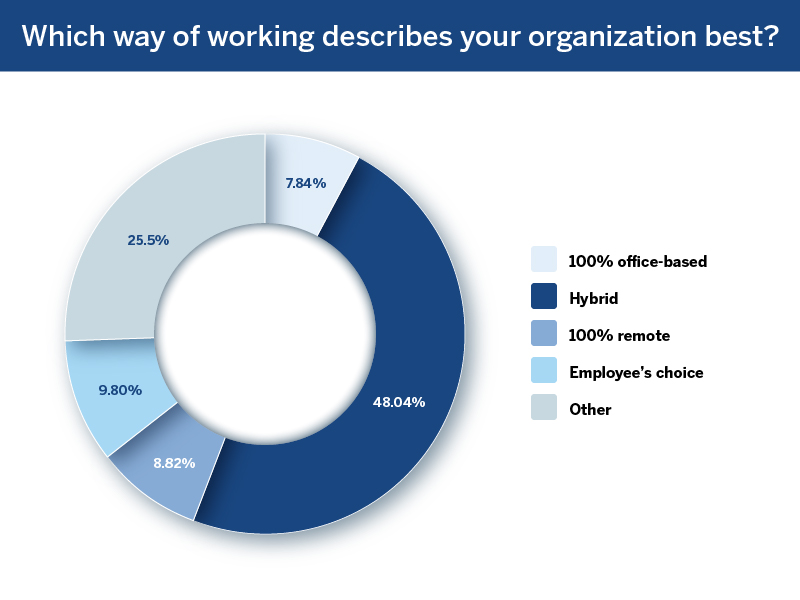
CHRR’s researchers analyzed the 100% remote category further and of the total 8.82% of firms who are fully remote, 6.86% were operating under that policy pre-pandemic.
A quarter of respondents didn’t match any of the categories. One firm was Vancouver-based Coast Mental Health, who help individuals with mental illness, and offered an insight into their strategy by saying they were only able to offer hybrid working to some of their employees because “others cannot work at home due to nature of role”. Also dealing with a split approach due to the operations in their hundreds of locations across Canada was Westland Insurance who added, “It’s a combination - retail is in office, corporate is hybrid.”
While some respondent organisations that wished to remain anonymous commented on what bespoke policies they use:
- “Generally, 100% office based for head office staff but with flexibility for some staff depending on position to work from home periodically. Sales team of seven in USA, Canada, and UK all work from home-based office and on the road.”
- “Hybrid if in city and possible 100% remote if living over 100 kms from office.”
- “Employee self-choice for head office staff only.”
- “Jobs that allow for hybrid work may work up to 50% from home. Most positions require staff to be 100% on site (public service).”
How much Hybrid is a good thing?
While the preference is for Canadian companies to operate in a hybrid fashion, there are still are key decisions to make.
CHRR’s research shows 61.45% of firms mandate a set number of days per week to employees.
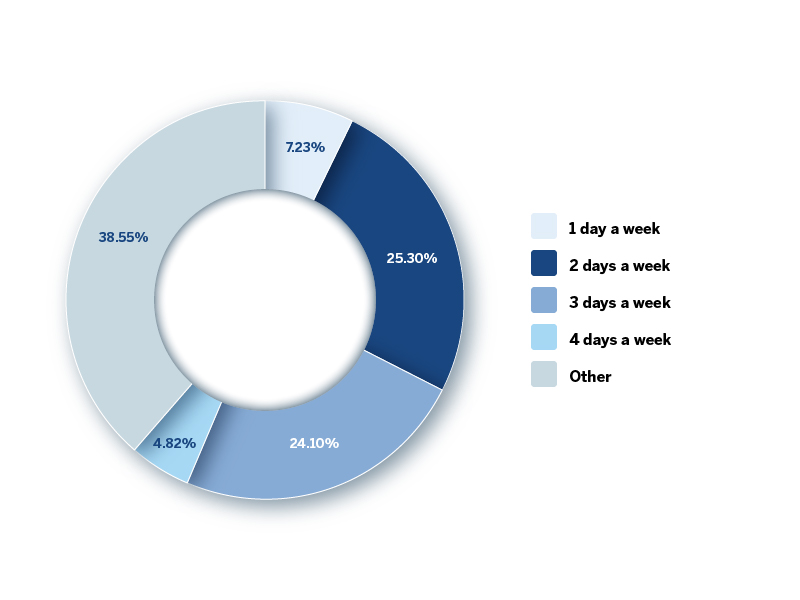
However, the remaining 38.55% have developed their own hybrid programs and have a variety of reasons.
Rifco National Auto Finance Corporation, headquartered in Red Deer, Alberta, operates a set pattern that is not necessarily numbers of days a week. A spokesperson explained, “We do one week out of three. This is only for a couple departments. The others have some remote, some office only and some hybrid.” Other firms require attendance as the ebbs and flows of the business requires. One example of this approach is The Mutual Fire Insurance Company of British Columbia which follows a needs-based approach. Its attendance requirements are, “as required for project meetings or townhalls.”
Also explaining their bespoke policy is Ontario’s Libro Credit Union who told researchers, “Some staff are remote by employee choice, some are mandated hybrid, while other are mandated 100% branch based. All dependent on role. Our hybrid staff decide when they need to be on location to meet needs of their role.”
At one end of the spectrum is nationwide corporation Info-Tech Research Group, which does not mandate anything and leaves the decision entirely with their staff, “We have a flexible work arrangement as per the choice of the employees.”
Hybrid forever?
The decision to embrace hybrid working looks like it isn’t permanent. In EY’s Future Workplace Index for 2023, only 1% of American executives said their company was fully remote, compared to 34% of respondents having a remote model (fully or mostly) in 2022.

EY’s Future Workplace Index for 2023
Although the E&Y study shows a rapid retreat from fully remote work, CHRR’s research shows that for Canadian firms at least, full time return to the office may not be happening anytime soon. For those respondents who operate a hybrid model, 78.75% of firms feel it is very unlikely or unlikely that they will ever return to being office-based.
Possible reasoning is suggested by StatCan data which shows that three times as many remote workers feel they work better at home, than those who feel productivity drops. 30.8 % of men and 33.9% of women feel they accomplish more work per work being remote, compared to 9.7%/9.4% who report accomplishing less work per hour.
For those who felt their productivity dropped, their main barrier to productivity was a lack of interaction with co-workers.
Canadians also report their preference is not to be fully office based with a study by Angus Reid showing only 4% of women and 3% of men opting for this when given the choice.
Another study by Zoho which canvassed 1,271 Canadian business leaders about business performance found that 60% said they are more productive working remotely.

Hybrid worries
Being concerned about productivity is not a new issue for executives. However, the explosion in remote working has created a new series of issues.
There are a series of legal issues such as occupational health and safety as the home has become an extension of the workplace. Employers must still provide a working environment that is safe, even if that is the employee’s home. For example, a Quebec Administrative Labour Tribunal in 2021 ruled that an Air Canada employee was eligible for worker’s compensation after injuring herself going down her own stairs for a lunch break. Additional issues to be considered include providing on-job training and ergonomic workstations.
The complexity extends to jurisdictions as provincially regulated employers have to be aware of the minimum standards in the locations their employees are working, if it’s different from the jurisdiction of their office. A team member who opts to work from home, may have different statutory holidays, work-hours and overtime rules, along with varying termination rights.
While all of these demand consideration, CHRR focused on employer’s direct concerns relating to their staff’s productivity.
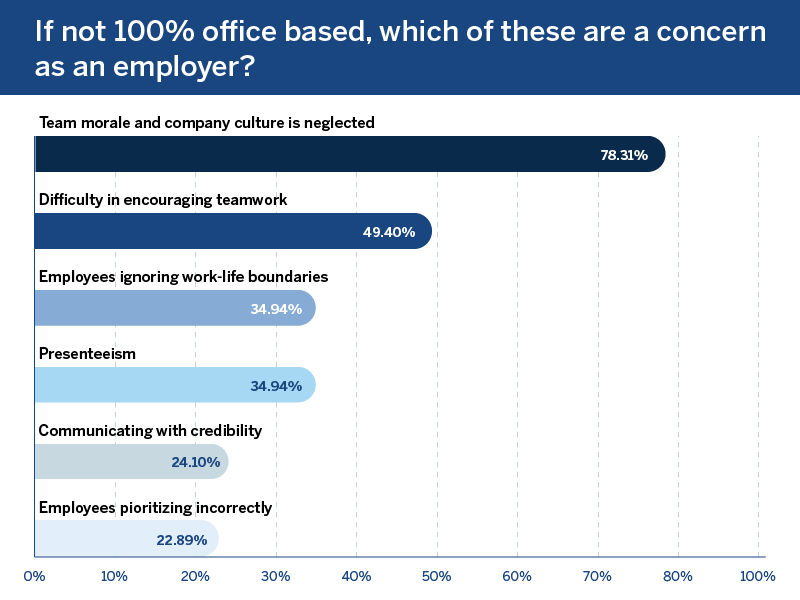
A standout factor that employers highlighted to CHRR was organic learning by colleagues being around each other, with knowledge and information shared informally. Westland Insurance explained their reservations about remote working, “Collaboration isn't as effective. It’s harder to learn from others as you're missing out on overhearing conversations.” Similarly, Info-Tech Research Group feels there are issues with insight being passed between colleagues as they listed their concerns as employees missing out on, “learning from impromptu conversations, coaching in the moment, and hearing your colleagues working.”
Other factors highlighted by respondents who wished to remain anonymous included:
- “Networking, informal opportunities.”
- “Employee mental health, specifically the impact of lack of separation between work and non-work.”
- “Less collaboration and spontaneous brainstorming.”
- “Morale impacts on the employees who cannot do their work remotely and as such are not eligible for hybrid work (this is about 70% of our employees).”
How many days do Canadians choose to be in the office?
Respondents reported on how many times per week their employees come to the office.
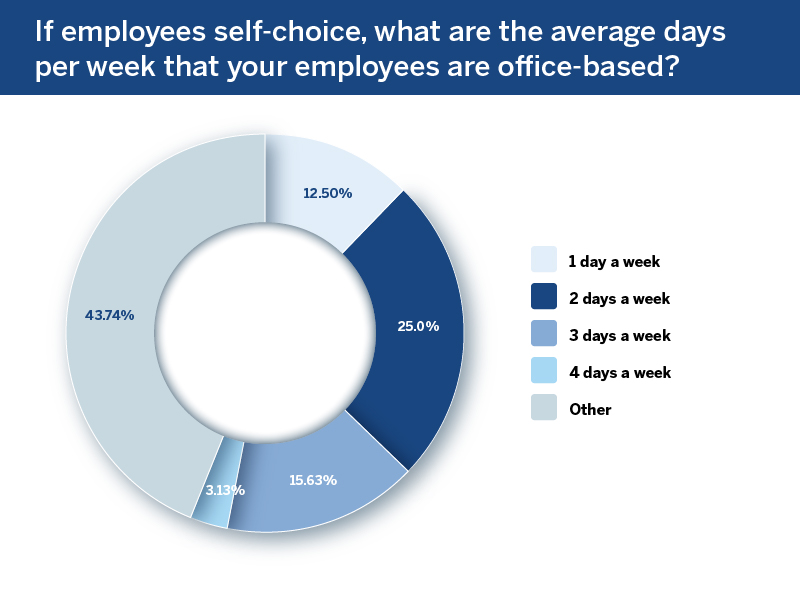
Two days was the most common if employees were afforded the choice, and CHRR’s data shows that workers have a range of reasons for selecting how many days they will attend in person.
This is illustrated by law firm Blakeney Henneberry Murphy & Galligan who reported, “Two of our lawyers work almost 100% remotely. Some support staff mix it up. A few support staff prefer to work exclusively at the office as they live alone and if not for coming into the office, they would see no one for days at a time.”
Still the most popular choice was Other, which is those organisations who do not require their employees to select a set number of days per week and allow the freedom to be spontaneous. Some of the reasons offered for this rationale is:
- “Monthly for social day or for special events only.”
- “Some teams choose to work from the office when they need to collaborate. Some individuals choose to work from the office if they need to get out of their house.”
- “They get one week in office, next week remote.”
Will Canadians embrace the 4-day week?
It’s a concept that receives a large degree of publicity. New Zealand has been one of the nations to embrace it more than most, with 40% of Kiwis expecting it to become a reality by 2028, according to Hays.
Global giant Unilever has enacted the concept in New Zealand and Australia, with staff retaining 100% of their salaries, while working 80% of the time and still committing to 100% delivery, known as 100:80:100.
Microsoft was another of the early pioneers of the concept when they ran it in their Japanese operations over a summer in 2019, which led to startling results as illustrated below.
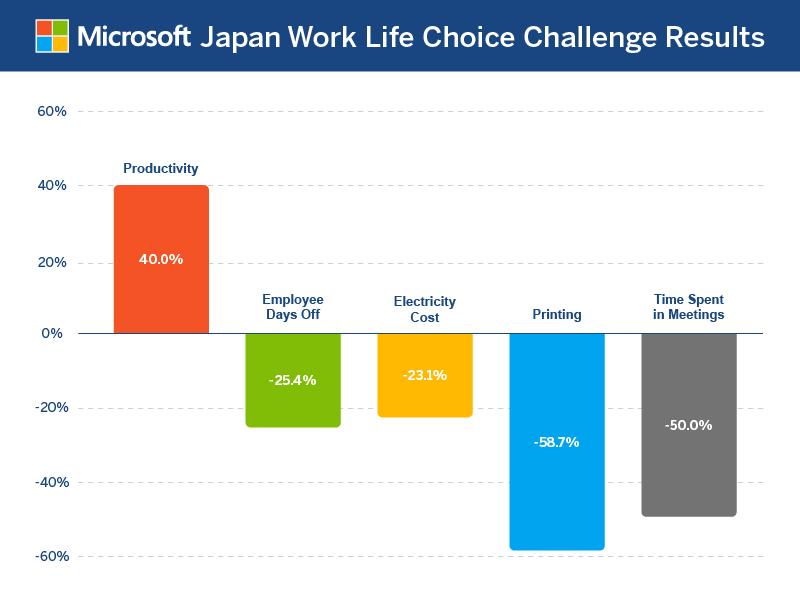
According to 4 Day Week Global, of the 41 US and Canadian companies who trialled a 4-day week for six months none were planning to return to five days.
In the UK over 60 companies took part in a trial organised by Autonomy and 92% reported they would continue with a shorter week following the programme. In turn 30% said they would make the policy permanent. The programme involved almost 3,000 employees and feedback showed that 39% were less stressed and 71% had reduced levels of burnout at the end of the trial. Likewise, levels of anxiety, fatigue and sleep issues decreased, while mental and physical health both improved.

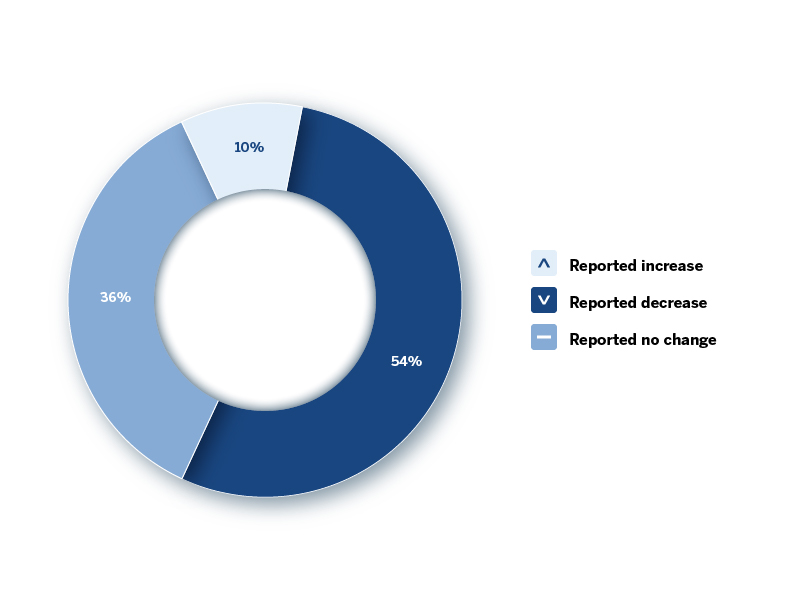
Reasons offered by various firms who discontinued the practice relate to operational issues. Examples include being not ready to implement it across different sites and some reported with the weekend being their busiest time, they were unable to offer a 3-day weekend as it meant staff had to cover shifts during these days and employees were not keen to have their days off midweek. Professional services is a sector where the concept works best due to the longer nature of project deadlines and lack of a need to serve the public directly, compared to retail or leisure.
However, CHRR’s data illustrates that few employees in Canada are being afforded the chance to embrace 100:80:100 and find out if it appeals to them.
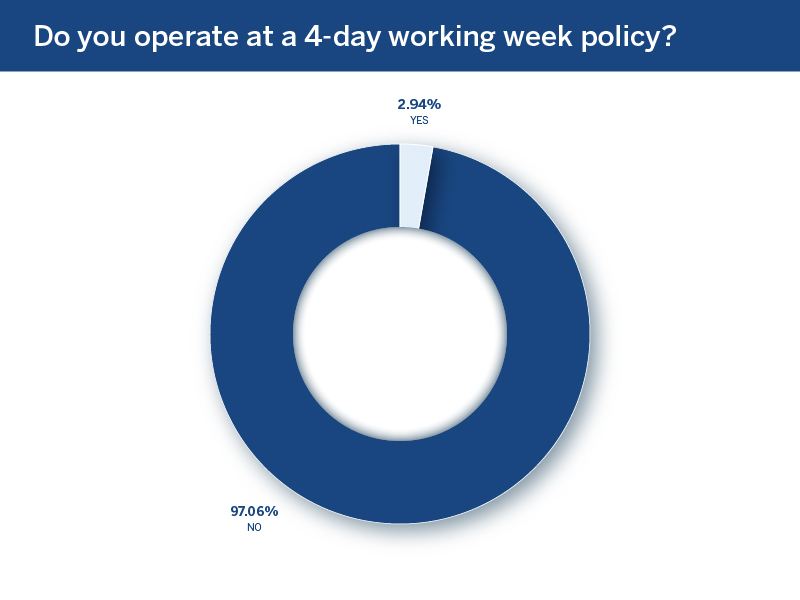
Change on the horizon or not?
There are variations in how many days are mandated in the office and the concerns for companies about hybrid working, and the same extends to long-term outlook.
Almost 80% of respondent firms have no plans to change their system.
Of the remaining 20%, the most common plan is to make alterations in the next six months.
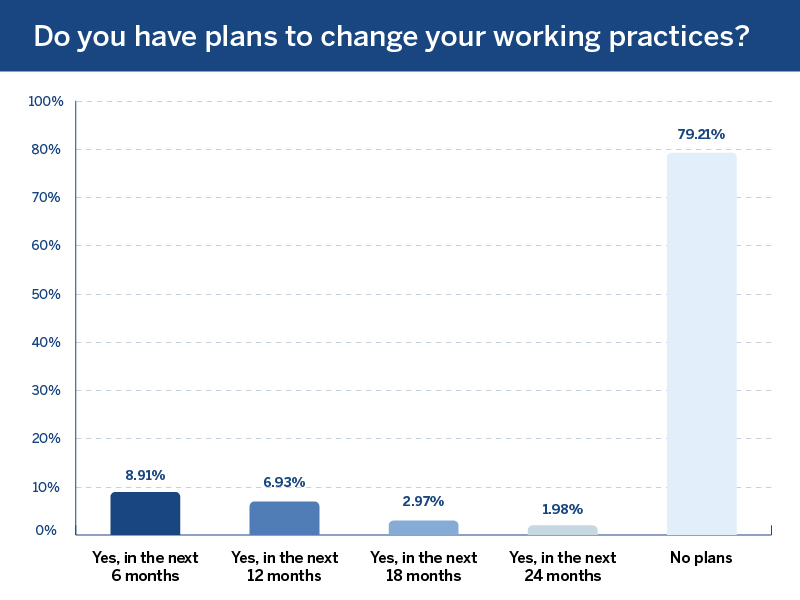
Does location matter?
CHRR’s data features insight from some household names in Canada, who have operations spread nationally and globally.
The figures show that 65.08% of respondents apply a unilateral system in their offices, both in Canada and internationally.

Some of the organizations offering feedback on the issue included Centurion Asset Management Inc who explained, “We operate apartment buildings, those employees who work on site are required to be at the building for their shifts.” While for The Mutual Fire Insurance Company of British Columbia it was a matter of time zone, “Staff are located in provinces across Canada. Start times vary in Eastern provinces but all other aspects align.”
Whereas for construction company Multiplex, the key factor was the individual’s job requirements as they replied, “Needs of the business determine who can work from home.”
While those organisations who wished to remain anonymous added:
- “Employees who are within office proximity are required to go to office at least once a month. If employees are far from office, they stay remote.”
- “Depends on role.”
- “Manufacturing and distribution employees must attend work location, those in the corporate office are self-choice.”




